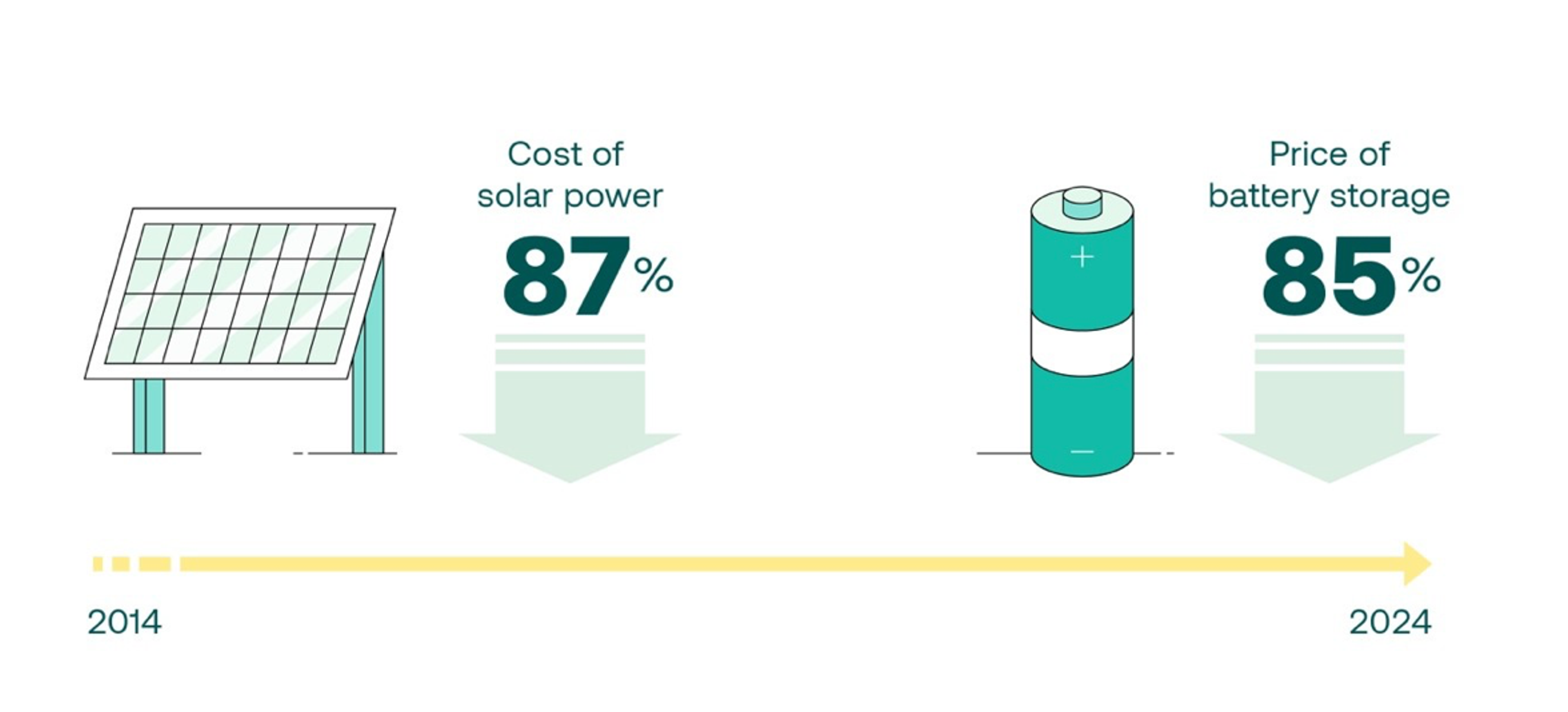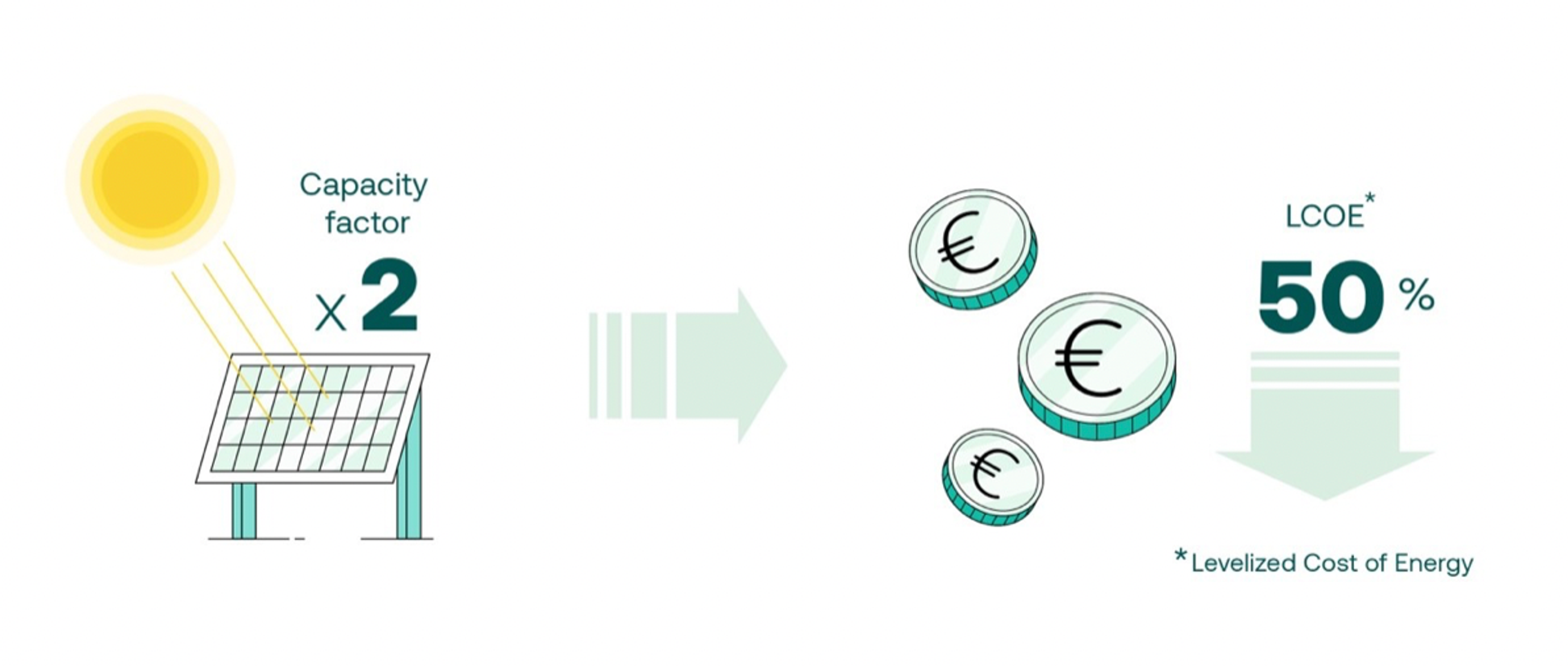
The simple sense of generating solar power where the sun shines strongest
April 18, 2024
Reading time: 5 min
The plummeting price of solar power—and other renewable and green technologies—means that the climate transition may in fact end up a lot cheaper than we initially thought.

In just the last 10 years, the cost of solar power has fallen 87%, with the price of battery storage falling 85%. Heat pumps, wind power, and other fossil-free technologies have also seen a sharp price drop.
“Renewable costs have been trending down for decades, and hydrogen will drive this cost down even more so, to permanently make them cheaper than oil and gas.” says Marco Alverà, TES’ Co-founder and CEO
And as great as it is for the green transition, there’s still a lot of work to be done.
The cheapest ever price for solar power per kilowatt hour was driven by Paddy Padmanathan and his team at ACWA Power, an energy production and water desalination provider headquartered in Saudi Arabia. ACWA would repeatedly break their own low cost records and continually drive down prices across the market.
We sat down with Mr Padmanathan recently to learn how he and his team managed to drive this price drop, why putting panels where it’s sunniest makes so much sense, and how we need to change our mindset to build for a better, more equitable future.
But first, a little primer on LCOE
Imagine you’re a government that wants to build a photovoltaic (PV) solar power plant. You ask companies to submit tenders to lay out their proposals, cost calculations, profitability forecasts, yield expectations, and long-term viability. Which one are you going to choose?
One of the most important factors you’ll examine in each tender is the Levelized Cost of Energy (LCOE). The LCOE indicates how much it will cost to produce energy from a given facility over the course of its entire lifetime. The cost of building and running the plant is divided by the amount of energy you expect to generate. This baseline price will affect how much you can then charge for that power.
The LCOE of solar power has been decreasing rapidly over the last few decades, driven by competitive tenders, improving technology, increased efficiency, and innovative, future-focused thinking.
How did ACWA Power drive down the cost of solar?
One of the challenges of building long-term renewable power projects is in trying to plan for an unpredictable future. The information you have today may not be relevant in a few decades’ time.
However, you can learn from history, observe trend patterns, depart from accepted pricing structures, focus on the future, and place some educated bets. This is what Padmanathan and the ACWA team focused on when they submitted their first tender almost 20 years ago.
“To minimize the risk of our price becoming irrelevant in the future as technology improves, we focused on keeping the cost down, [and got] away from the concept of market pricing”, says Paddy Padmanathan.
“If you start applying that kind of principle with the right kind of people who can design fit-for-purpose solutions, you can convince your supply chain to partner with you [based on] that philosophy and you can really achieve miracles, as we saw and consistently proved over 18 years and 65 tenders.
“That's what allowed us to continue to keep challenging our own price. [...] But how do we keep driving the cost down? Because technology has continued to deliver at a lower and lower cost, at a greater and greater efficiency. [...] But we, the players, must also adopt the right attitude.”
Driving down costs by increasing efficiency
Evolving technology is certainly crucial to driving change, but it’s only one factor in a broader picture. The renewable energy projects of the future are also propelled by an equitable global outlook, ambitious vision, and pragmatic decisions.

Source: Global Solar Atlas
Putting solar panels in locations where the sun shines strongest, for example, is a no-brainer. When PV fields can operate at peak efficiency, the cost of generating solar energy drops dramatically. Take Middle Eastern countries, which boast a PV power output potential nearly double that of Germany.

For solar power projects, choosing a sunnier location with a capacity factor twice as high can reduce LCOE by around 50%. “The evidence of how competitive renewable is”, says Mr Padmanathan, can be seen in the changing behavior of traditionally fossil-focused locations like Saudi Arabia and the UAE.
“These are the centers of oil and gas production [and the cost of] producing oil and gas in these countries is minuscule. Yet they are implementing renewable energy at scale. Yes, they are doing it to decarbonize, to fulfill their Paris commitments. But at the same time, it is also because it is the most competitive solution to supply energy when the sun is shining or when the wind is blowing.
“[Renewable projects are] capital intensive, [light on] operational costs, [with] zero fuel cost. Provided you can continue bringing the capital costs down, ultimately it will become the cheaper solution.”
In short, putting panels in sunny locations makes sense because it drives down the cost of solar energy production and increases operational efficiency which enables abundant supply at reasonable retail prices.
Building a greener future requires a new attitude
Moving away from solely profit-driven market pricing allowed ACWA Power to revolutionize the cost at which they could generate and provide solar energy. Very few people believed in their calculations at the time, but the last two decades have proven Mr Padmanathan and his team correct. If anything, he says, they weren’t ambitious enough.
Informed, rational decisions coupled with climate optimism can allow us to think beyond what has felt possible up to this point. To change the norm, we need to foster a more flexible mindset.
“Look at the spectacular progress humanity has achieved so far,” says Mr Padmanathan. “[The] energy transition is an opportunity. Energy is so fundamental to all we do, to how we live.”
“We can keep driving that cost down and widening access to that energy. Sun shines across the world, wind blows across the world, and now technology has allowed us to capture that energy, even at a very small level in a much more economic way.
“So I think we need to stop thinking about the doom and gloom scenarios. [...] I think we need to place more faith in human ingenuity, human resilience, human capacity.”